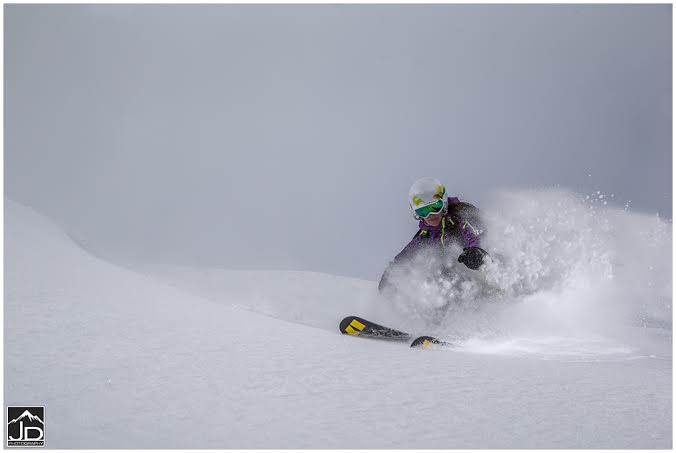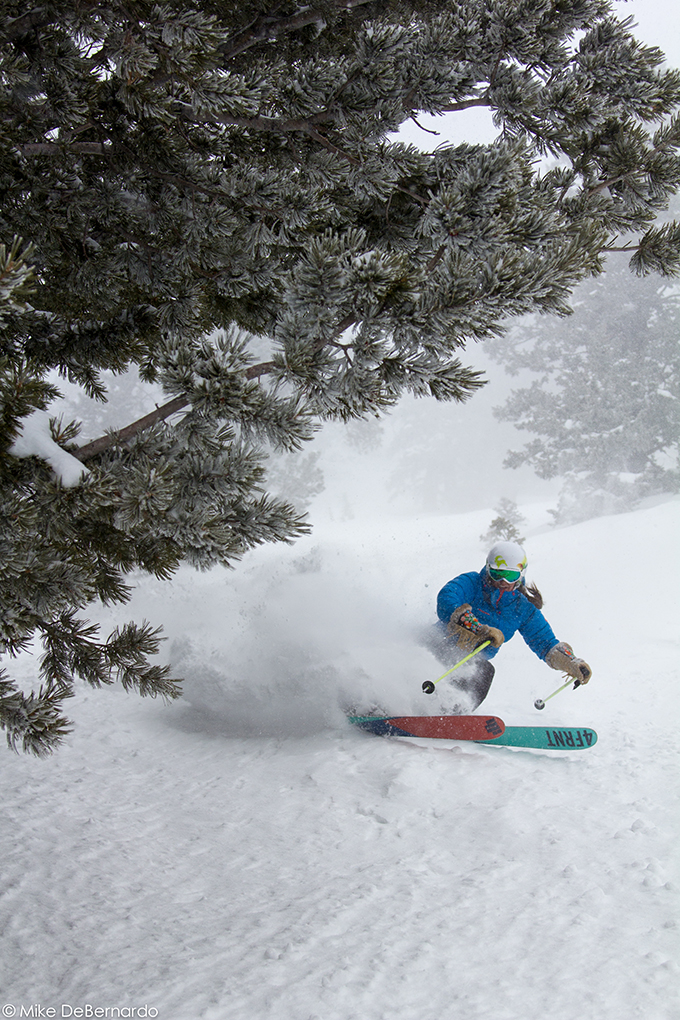
2014-2015 Dalbello Women’s KR 2 Kryzma I.D. Ski Boot
Size Tested: 22.5
Available Sizes: 21.0 – 26.5
Boot Sole Length: 267mm at 22.5
Stated Flex: 115 for B “Medium” tongue and 130 for C “Stiff” tongue.
Stated Last Width: 98mm
Blister’s Measured Weight per Boot
(with stock liners and custom footbeds): 1750 & 1751 grams
Features:
- 3-piece design
- Two interchangeable tongues
- 2 boot boards (Firm & Anti-Shock)
- Solid lug sole
- Liner: I.D. Thermo Pro Lady (heat moldable)
Reviewer Info:
- 5’3”, 120lbs
- Street Shoe Size: 6.0
- Feet: narrow forefoot, very low arches, skinny heels, large calves
Test Locations: Alta Ski Area, Snowbird, Powder Mountain, Grand Targhee Resort
Days Skied: 70+
MSRP: $600
If you’re an aggressive, experienced female skier who is looking for a stiff, high-performance boot, but have rather small feet, your available options are fairly limited. The Dalbello Kr 2 Kryzma I.D. is one of few women’s boots produced in a shell size smaller than 23.0, with a flex rating greater than 100.
With so few boots available that fit this description, I was hopeful that the Kryzma could deliver the proper fit and level of performance I needed. After more than 70 days in the boot, I can say it does. If you’ve been faced with this sizing/performance dilemma before, but haven’t found a boot that works for you, I’ve got some good news.

Sizing & Fit Process
To have the Kryzmas fit, I headed off to one of Blister’s Recommended Shops, Inkline Foot Science, in Salt Lake City. They first helped me thermomold a pair of custom footbeds from Sidas Sports. A custom footbed creates a foundation that mirrors the shape of the bottom of your foot in order to stabilize it and ensure you can transfer the maximum force to the edge of the ski. (No matter what pair of boots you’re buying, we recommend investing in a custom pair of footbeds—they’ll ensure you get the best possible fit with the boot you end up in, and can be re-used for numerous seasons to come in future pairs of boots.)
The next step was to mold the Kryzma’s Intuition I.D. Thermo Pro liner. Out of the box, standing in the size 22.5 for more than 5 minutes was nearly intolerable. After molding the liners, the fit was still uncomfortably snug, but I could immediately tell the boots were providing better heel retention than any other boot I had worn, and this “suspiciously tight” fit is just what you want to achieve a proper performance fit.
It’s also worth noting that the Kryzma’s snug fit felt especially tight as I was used to wearing my previous pair of boots: the 2010-2011 Nordica Firearrow F3 in a size 23.5. Not only was that shell size too large for me, the liner had packed out so much that I was experiencing about half an inch of heel lift while skiing.
Apart from the Kryzma, I also tried on the women’s Rossignol AllTrack Pro 110, one of the few other boots with a flex over 100 that comes in a shell size smaller than 23. However, the Alltrack 110 has a 100mm last, whereas the Kryzma is narrower, at 98mm. Given my narrower feet, the fit of the Alltrack proved too roomy for me in a size 22.5. In the same size, the Kryzma’s narrower last suited my foot shape much better and provided a nice, snug fit. I especially like the placement of the Kryzma’s “Dynalink” middle buckle, as it locks my heel and instep in place better than any 4-buckle boot I’ve used, and provides great stability on snow, as I’ll explain.
(To learn more about a performance/race fit vs. a more relaxed fit with respect to a boot’s shell size, check out Charlie Bradley’s Boot Fitting 101.)
The Kryzma has a 4 degree ramp angle and 11 degrees of forward lean, which promotes a fairly upright, neutral stance. You can install shims at the back of the boots’ cuffs that push the forward lean to a more race-oriented 13 degrees, but in general the Kryzma is designed more with playful, modern ski designs in mind.
Fit Adjustments
I skied about 30 days on the Kryzmas before I decided I needed to head back to Inkline for some adjustments. With no alterations to the shell, the boot’s toebox proved too small to accommodate my toes comfortably, and I was experiencing some numbness and discomfort. The guys at Inkline determined that the issue lay specifically with the height of the Kryzma’s toebox, and they punched out the toe a bit to create a bit more volume above my toes. With this adjustment, the fit of the boots was 100% dialed.
Warmth
Dalbello claims Kryzma’s I.D. Thermo Pro liners provide “exceptional warmth.” Unfortunately, my experience wasn’t at all close to matching this claim, and for me, warmth was the one shortfall of the Kryzma. I don’t have particularly sensitive feet, but I often experienced cold toes and numbness in these boots. On a number of occasions, even after the height in the toe-box was corrected and while skiing with the bottom buckle of the boot undone, I had to go inside for a couple minutes to take the boots off and let my thaw my feet out. This was in temperatures in the high teens and low 20s.
Wearing very thin ski socks helped promote better circulation in the Kryzma, but if you have particularly cold, sensitive feet, you may need to invest in some boot heaters or a warmer aftermarket liner to wear the boot comfortably on cold days.
These warmth issues aside, the boot’s on-snow performance is outstanding…
Performance
The Kryzma is a 3 piece boot, made up of the the lower shell, the upper cuff, and the tongue. Two different tongues are included with the Kryzma: a “medium” stiffness tongue, with a stated flex of 115, and a “stiff” tongue with a stated flex of 130.

I opted to use the stiffer, 130 flex tongue in the Kryzma. Remember that flex ratings are not standardized in the ski industry, so one “130 flex” boot might feel softer or stiffer than another boot with a 130 flex rating. Even so, the forward flex of the Kryzma felt smooth, precise and decidedly much stiffer than the reported 105 flex on my old Firearrows.
There are also two bootboards (or zeppas) included with the boot: a stiff rigid footboard and a softer, more flexible “anti-shock” bootboard. I only used the stiff bootboard in the Kryzma this past season, but will update this review as soon as possible as I get the chance to compare it to the softer version. I can say that the stiffer board, as expected, didn’t impede the boot’s responsiveness at all, nor did it seem overly harsh/firm either.
